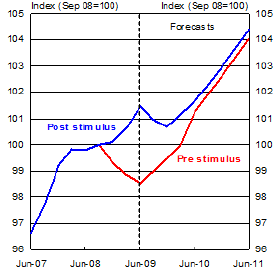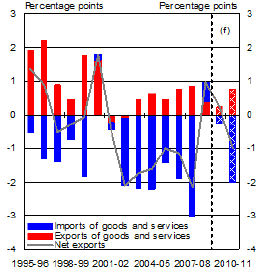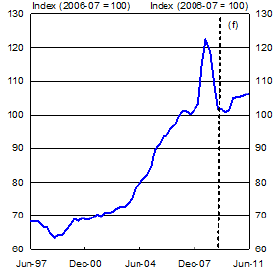Outlook for the domestic economy
The forecasts for the domestic economy are underpinned by several technical assumptions. The exchange rate is assumed to remain around levels observed at the time the forecasts were prepared (a trade-weighted index of around 66 and a $US exchange rate of around 83c). Interest rates are assumed to rise in line with market expectations over the forecast period. World oil prices (Tapis) are assumed to remain at around $US 78 per barrel. The farm sector forecasts are based on an assumed return to average seasonal conditions over the remainder of forecasting period.
Household consumption
The household sector has remained resilient, despite significant wealth and confidence effects associated with the global downturn. Consumer confidence has improved markedly, supported by the Government's cash payments and sustained low interest rates. The improved outlook for the unemployment rate has also bolstered consumer confidence.
Household consumption grew by a solid 0.8 per cent in the June quarter. However, consumption growth is forecast to be negative in the September quarter, as the effects of the cash payments begin to wane. This is supported by a decline in retail sales figures in June and July.
Chart 1: Retail trade

Source: ABS Cat. No. 8501.0.
The outlook for household consumption in 2009-10 is broadly unchanged, with growth forecast to be a subdued ½ a per cent. Household consumption is expected to grow by 2¼ per cent in 2010-11, supported by a more benign outlook for the labour market.
Chart 2: Effect of stimulus on consumption

Source: ABS Cat. No. 5206.0 and Treasury.
Dwelling investment
The recovery in the dwellings sector appears to be emerging as expected. House prices grew by a buoyant 4.2 per cent in the June quarter, the strongest growth since 2007, although this outcome was likely influenced by the temporary effects of the First Home Owners Boost. Recent housing finance and building approvals data imply a recovery in the sector strengthening from the September quarter 2009, with dwellings investment forecast to grow 12 per cent in 2010-11.
The imminent recovery in the sector will be supported by improved household confidence, low mortgage interest rates and the more benign unemployment outlook. In addition, longer term fundamentals, such as strong population growth and high rental yields are also expected to support growth.
Despite the upbeat outlook for the sector, pockets of weakness remain. On-going credit constraints, particularly for medium and high density developments, continue to weigh on the sector. In addition, the prospect of higher interest rates could also moderate the recovery in dwelling investment in 2010-11.
Chart 3: Private Dwelling investment (real)

Source: ABS Cat. No. 5206.0 and Treasury.
Business investment
On balance, the outlook for business investment has improved, in line with better than expected domestic conditions and the improved outlook for the mining sector. However, the outlook is markedly different for each component of investment.
Business conditions and sentiment have rebounded strongly from their lows over recent months. Business surveys have indicated some improvements in investment intentions although it takes time for improvements in sentiment to translate into activity. Continued weakness is expected for the remainder of calendar 2009.
Total new business investment is expected to post a smaller than expected decline of 9 per cent in 2009-10 before recovering in 2010-11 to grow by 5½ per cent.
Chart 4: New non-residential building and engineering construction

Source: ABS Cat. No. 5206.0 and Treasury.
The outlook for engineering construction investment has improved significantly on the back of a stronger outlook for commodities. This stronger outlook is underpinned by the increasing number of large resources projects that are now more likely to proceed.
New engineering construction is expected to increase by 3½ per cent in 2009-10, followed by a strong increase of 13 per cent in 2010-11, supported by a handful of high value projects in the oil and gas sectors beginning to ramp up construction, including the Gorgon LNG project.
There are clear risks to these forecasts as there remains uncertainty surrounding the precise timing of these major projects over the next few years.
Forecast investment in new machinery and equipment is marginally stronger than the June update. Investment is expected to decrease by 11 per cent in 2009-10, reflecting subdued domestic demand and the staged withdrawal of the Small Business and General Business Tax Break. Investment is expected to rebound strongly in 2010-11 by 7½ per cent, supported by the improved outlook for corporate profits and the domestic and international economies.
The outlook for non-residential building investment remains depressed. A combination of weak private sector building approvals and on-going credit constraints continues to weigh on activity. In addition, new supply being completed over the next two years is expected to push up vacancy rates, further depressing investment. As a result, non-residential building activity is expected to plunge by 23½ per cent in 2009-10 and by a further 9 per cent in 2010-11.
Public final demand
Public final demand is expected to grow strongly in 2009-10, as the direct spending under the Government's stimulus packages ramps up. New public final demand is expected to grow by 7¾ per cent in 2009-10 and by ½ of a per cent in 2010-11, slightly higher than in the June update.
As illustrated by Chart 5, the withdrawal of the packages is expected to detract from growth from the March quarter of 2010 onwards, as private sector activity begins to contribute to growth. However, the packages will remain important to supporting the overall level of activity in the economy.
Chart 5: Contribution of fiscal stimulus to GDP growth

Source: ABS Cat. No 5206.0 and Treasury.
The expected stimulus profile is based on updated information received from the states and territories and the Office of the Coordinator-General about activity under the major infrastructure programs. This exercise has suggested some slippage in the expected timing of activity, with more activity from the infrastructure packages now expected to be in the first half of 2010. There remains a risk of further slippage in infrastructure activity, which could result in some of this investment occurring when private activity has already begun to recover, putting upwards pressure on labour and capital costs.
Exports, imports and the current account deficit
Export volumes are continuing to perform better than anticipated, driven by stronger demand for Australia's bulk commodities such as iron ore and coal.
Total export volumes are now expected to grow
modestly, rather than contract, in 2009-10, before strengthening in 2010-11 to grow by 4 per cent, reflecting the anticipated recovery in the global economy.
Non-rural commodities are expected to grow by 3 per cent in 2009-10, a reversal from the contraction expected in the June update, reflecting a stronger outlook for world commodity demand and an expected increase in Australian iron ore production capacity. Strong growth is also forecast for 2010-11.
Commodity demand has continued to hold up, driven by infrastructure investment under the Chinese government's stimulus package. Further, lower prices for iron ore and coal as well as concerns about mine safety, have led to closures of some Chinese mines, driving a number of Chinese steel producers to switch to lower-cost Australian coal and iron ore. Steel production in the rest of the world is also beginning to show signs of recovery.
Farm production is forecast to grow by 4 per cent in 2009-10, with rural exports growing strongly due to better than expected rainfall patterns in some areas.
Stronger world growth, coupled with a higher Australian dollar, provides a mixed outlook for elaborately transformed manufactures (ETM) and services exports. ETM exports are expected to contract by 11½ per cent in 2009-10. Services exports are expected to decline by 1 per cent in 2009-10. Services exports have held up better than expected, in part due to on-going strength in education exports to China and India. However, weakness in the inbound tourist market is expected to lead to a fall in services exports.
Strengthening global growth is expected to lead to a gradual recovery in ETM and services exports in 2010-11.
Imports of goods and services are expected to rise by 1 per cent in 2009-10 and 8½ per cent in 2010-11, reflecting a higher Australian dollar, inventory rebuilding and broad strength in private sector demand going forward. These factors are expected to drive growth in both capital and consumption goods imports.
Net exports are expected to contribute ¼ of a percentage point to GDP growth in 2009-10, lower than at June, in line with stronger import volumes. Net exports are expected to detract 1 percentage point from growth in 2010-11 as import volumes recover faster than export volumes.
Chart 6: Net exports – contribution to GDP growth

Source: ABS Cat. No. 5206.0 and Treasury.
Chart 7: Non-rural commodities
(CVM)

Source: ABS Cat. No. 5206.0 and Treasury.
The terms of trade are forecast to decrease by 9¾ per cent in 2009-10, a smaller fall than expected at June – largely due to the appreciation of the Australian dollar and higher spot commodity prices. Contract prices for Australia's bulk commodities such as iron ore and coal have fallen in line with our expectations. The terms of trade are forecast to increase by 3½ in 2010-11 as coal and iron ore contract prices increase in line with growing world demand.
Chart 8: Terms of Trade

Source: ABS Cat. No. 5206.0 and Treasury.
The forecast for the current account deficit (CAD) has increased since June to 5 per cent of GDP in 2009-10, before widening to 5¼ per cent in 2010-11. The 2009-10 trade balance forecast is marginally narrower than in the June update, with a slight widening in the trade deficit expected in 2010-11, in line with stronger imports. The net income deficit (NID) is expected to be 3½ per cent of GDP in 2009-10, larger than forecast at June, driven by an increase in both the net equity and net debt income deficits since the June update. This reflects a smaller than previously expected fall in equity income paid to foreigners and a larger than previously expected debt liability stock.
Chart 9: Current Account Deficit

Source: ABS Cat. No's. 5206.0, 5302.0 and Treasury.
Employment, wages and inflation
The employment outlook has improved in line with the stronger outlook for the real economy.
Employment growth is expected to remain flat through the year to the June quarter 2010, which is considerably stronger than the 1½ per cent contraction forecast at the June update. In through-the-year terms, the contraction in employment is now expected to bottom in late 2009. This would amount to a considerably smaller fall in employment than in previous downturns.
In the current downturn, many employers appear to have reduced staff working hours in many cases in preference to job shedding. Indeed, the recent fall in total hours has been significant, and is greater than implied by recent GDP outcomes. The fall in average hours is expected to be reversed over the forecast period.
Chart 10: Employment growth and total hours (sa)

Source: ABS Cat. No 6202.0 and Treasury.
A more moderate deterioration in employment is expected to result in a lower peak unemployment rate than forecast in the June update. The unemployment rate is expected to rise to 6¾ per cent by the June quarter 2010 before peaking at 7 per cent in December quarter 2010. This is a more subdued rise than the peak of 8 per cent in March 2011 forecast in the June update.
After reaching all-time highs in 2008, the participation rate is beginning to moderate, although somewhat less sharply than envisaged in the June update. In line with the better outlook for the labour market, fewer discouraged workers are likely to leave the labour force and demand for overseas workers may not fall as sharply as expected in June.
The participation rate is forecast to reach 65 per cent in the June quarter 2010 before falling to 64¾ per cent in the June quarter 2011, slightly higher than forecast in the June update.
Chart 11: Unemployment and Participation Rates (sa)

Source: ABS Cat. No. 6202.0 and Treasury.
The outlook for wages growth is stronger than was expected at June, in line with the resilience of the Australian labour market and wider economy.
The National Accounts measure of Average Weekly Earnings fell in both the March and June quarters. These unexpectedly strong declines were likely driven by declining average hours worked and cuts in bonuses.
The near term outlook for average weekly earnings is lower than forecast in the June update. However, as the recovery takes hold and average hours recover, average weekly earnings are expected to grow faster than envisaged in the June update from mid 2010.
The Wage Price Index is expected to grow by 3¼ per cent and 3½ per cent through the year to the June quarters of 2010 and 2011, reflecting a slight revision from June update forecasts of 3¼ per cent for both years.
Underlying inflation is forecast to be stronger than forecast in the June update in line with a stronger economy, only partially offset by the effect of a higher exchange rate on import prices. Underlying inflation is expected to be 2 per cen
t through the year to June in both 2009-10 and 2010-11. Headline inflation is expected to be a little stronger than underlying inflation in 2009-10, reflecting higher oil prices, rising to 2¼ per cent through the year to June 2010.